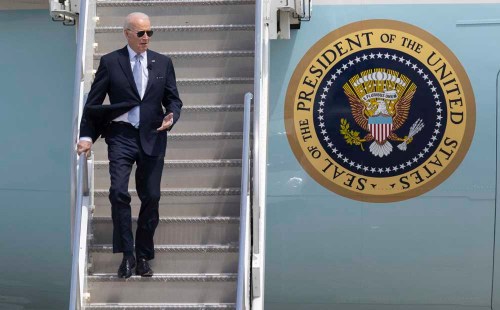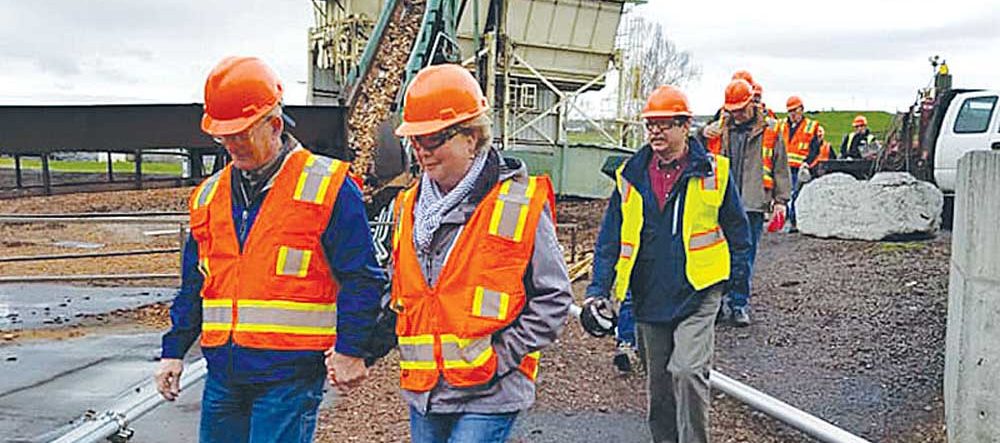Biden touts $1 trillion building plan. What’s in store for rural Oregon?
Published 5:00 am Monday, April 25, 2022

- President Joe Biden arrives in Portland via Air Force One on April 21, 2022. He's trying to stave off the usual midterm losses of the president's party two years after a presidential election. Oregon has three open U.S. House seats.
PORTLAND — President Joe Biden led a political pep rally Thursday, April 21, at Portland International Airport, which he called “a perfect example” of what the $1 trillion legislation he signed last year can do to overhaul the nation’s aging infrastructure.
The airport already is undergoing a $2 billion modernization project, including a greatly expanded passenger terminal and a new mass timber roof that will be its crown jewel. The airport already has benefited from $19 million in federal funds for runway work.
As Biden spoke to a crowd of elected officials and union workers inside a hangar at the Air National Guard base on the airport’s southern edge, the airport was visible through the hangar’s open door.
Biden thanked Oregon’s two senators and four of its five representatives — all Democrats — for their votes for the bill he signed on Nov. 15, 2021. (Oregon’s lone Republican in the House voted against it.)
“I want to thank them for helping prove that America can do big things again,” he said.
“There is a belief that we can’t do big things anymore. But we can. We have proven we can. And we must build a better America. A good place to start is right here in Portland. Portland International Airport is a perfect example of the need, the opportunity and our ability to make progress.”
Although some in Oregon’s congressional delegation talked about other big projects that could benefit from the new federal money — replacement bridges across the Columbia River connecting Portland and Vancouver, Washington, and the widening of Interstate 5 at the Rose Quarter interchange with Interstate 84 — Biden made no specific commitments.
He did say that $25 billion of the new money is earmarked for airports such as Portland, which sees 20 million passengers annually and ships 330,000 metric tons of goods.
According to World Economic Forum reports, the United States now ranks 13th in the quality of its infrastructure. Biden said the legislation is a start in changing that.
“Here’s the deal: It’s been much too long since America has invested in our own airports, our ports and our rails. We haven’t done it,” he said.
“We used to have the best infrastructure in the world. We stopped investing in ourselves. We stopped investing in our communities. We stopped investing in America. I know people are tired of hearing me say it. But this time, we are going to lead the world in investing in ourselves, in our nation and in our people. That is the place to start.”
After his 25-minute talk, Biden ventured to the Portland Yacht Club for a fundraiser. Protesters were encamped outside the club.
On the inflation woes that have hit the country, Biden blamed supply-chain problems exasperated by the COVID-19 epidemic, and gasoline prices. Before arriving in Portland, the president had linked gas price increases to the Russian invasion of Ukraine and worldwide sanctions against Russia.
He spent slightly more than three hours in Oregon before he left for Seattle.
What Oregon gets
Oregon will get at least $4.5 billion over five years, though much of that amount is in the form of renewed federal aid for highways. But at least $1.2 billion is new money for road and bridge repairs, mass transit and other alternatives to reduce carbon emissions from cars, safer streets and roads, infrastructure for electric vehicles and resilience from natural disasters and climate change. Most of this money is channeled through the Oregon Department of Transportation, but some goes directly to local governments.
Oregon also has the opportunity to compete for shares of $100 billion for projects determined by the U.S. secretary of transportation, such as the I-5 bridge and the I-5 widening mentioned above.
Biden, in a Jan. 14 video message, did mention the I-5 bridge replacement as one of three examples of bridges that could benefit from the legislation. That project is undergoing a supplemental environmental impact statement, which is required for projects likely to have a significant effect as defined in a 1970 law.
Oregon also will get aid for upgrades of water and sewer lines and expansion of broadband capacity. Leah Horner has been named by Gov. Kate Brown to oversee infrastructure spending.
The law’s effects
Biden has given similar speeches elsewhere, trying to marshal support for Democrats as they face a tough midterm election Nov. 8, when their tenuous majorities might fall to Republicans.
Biden won’t be on the ballot, and Democratic Sen. Ron Wyden and Reps. Suzanne Bonamici and Earl Blumenauer face little-known opponents. But Rep. Kurt Schrader faces a tough primary challenger, and there are spirited primary contests for two open seats, including the newly created 6th District, which weaves from Portland’s southern suburbs down through the mid-Willamette Valley. Rep. Peter DeFazio of Springfield, one of the chief architects of the infrastructure legislation, is retiring after 36 years in the 4th District seat.
Also speaking were Sen. Jeff Merkley, Portland Mayor Ted Wheeler and Gov. Kate Brown.
Biden was introduced by Lauren Heitzman, who had several jobs before she became an apprentice electrician with Local 48 of the International Brotherhood of Electrical Workers. She was raised by a single mother; she said they were not poor, but economic insecurities plagued them.
“To me, not only is this project a symbol of modern advancement and ingenuity, it is a vehicle for a promise of a better life,” said Heitzman, one of the workers on the airport modernization. “This airport is a landmark. I will forever drive by it and see it as a symbol of how far I have come. Projects like this change lives and keep Oregon moving forward.
“I have health care, I have a pension, I have the security of good pay — and with the extra income, I can take my mom grocery shopping whenever she wants.”
But Heitzman also said the new law and the ensuing work that it funds have a broader effect.
“The law that passed last year is not just an investment in infrastructure. It is also an investment in good union jobs, good schools and strong communities. It is an investment in me and my union,” she said.
“The men and women of the IBEW are just getting started. We are ready to rebuild the bridge over the Columbia River, modernize the port and upgrade the container crates that are so essential to this region’s commerce — and of course, finish this airport and make it a jewel of the Pacific Northwest.
“We are ready to build back America better,” playing on Biden’s “Build Back Better” theme.
Biden said she was one of about 1,250 workers on the modernization project, 95% of whom are represented by unions.
“They are the best workers in the world,” Biden said.









